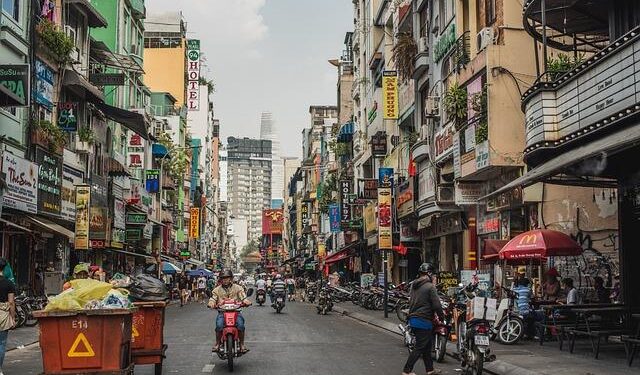in a critically important move to enhance foreign investment in its banking sector,Vietnam has announced that it will permit certain banks to increase foreign ownership stakes to as much as 49%. This decision marks a pivotal step in the country’s ongoing economic reforms and reflects its commitment to attracting global capital amidst an evolving financial landscape. In a context where many emerging markets are vying for foreign investment, Vietnam’s revised regulations aim to bolster its banking industry’s competitiveness and resilience while potentially bringing in much-needed expertise and technology. The decision has garnered attention from investors and financial analysts alike, as it could reshape the dynamics of banking in Vietnam and further integrate the country’s economy into the global market. This article delves into the implications of this policy change, the response from stakeholders, and what it may mean for the future of Vietnam’s banking sector.
Vietnam Banks Embrace Foreign Investment with New Ownership cap
In a significant move to boost the competitiveness and stability of its banking sector, Vietnamese regulators have announced a new framework allowing certain banks to increase foreign ownership to as much as 49%. This development comes as part of broader economic reforms aimed at attracting foreign capital and enhancing operational efficiency within domestic banks. Benefits of this new ownership cap include:
- Increased Capital Influx: Banks can expect a fresh influx of foreign direct investment, bolstering their financial bases.
- Technological Advancements: Partnerships with international entities are likely to introduce innovative banking technologies.
- Enhanced Governance: Foreign investors often bring superior management practices, improving overall governance within local banks.
This strategic shift aligns Vietnam’s banking landscape with global practices while providing a critical channel for diversified sources of funding. Recent analyses indicate that the influx of foreign investment may also lead to intense competition among banks, potentially benefiting consumers through better services and lower fees. Notably, the central bank has specified that only selected banks meeting certain criteria will qualify for this elevated foreign ownership ratio, ensuring that stability remains a priority.
| Criteria for Eligible Banks | Details |
|---|---|
| Financial Stability | Must demonstrate consistent profitability over the last three years. |
| Regulatory Compliance | Must comply with all existing banking regulations set by the State Bank of Vietnam. |
| Growth Potential | Potential for enduring growth in both retail and corporate banking sectors. |

Implications of increased Foreign Ownership on Vietnam’s Banking Sector
The recent policy shift allowing foreign ownership of up to 49% in select Vietnamese banks represents a significant turning point for the nation’s financial landscape. This change is expected to encourage increased capital influx from foreign investors,enhancing the liquidity and stability of domestic banks. With a more significant foreign presence, we could see improvements in operational efficiency and risk management practices, which are essential for addressing the challenges faced by Vietnamese banks. Moreover, foreign partners often bring advanced technology and international best practices, which can lead to greater customer satisfaction and innovation in banking services.
Though, this increased foreign ownership raises several potential challenges. The concentration of foreign capital could lead to heightened competition among banks, potentially putting pressure on smaller local entities that may struggle to adapt to the changing dynamics of the market. It also raises concerns about economic sovereignty, as key financial decisions may increasingly reflect foreign interests over national priorities. Policymakers need to strike a balance between welcoming foreign investment and ensuring that the local banking sector remains robust and competitive. the implications of this policy shift will unfold in the coming years, revealing both opportunities and challenges for Vietnam’s banking sector.

Analyzing the Effects on Local Banks and Market Competition
The recent move by the Vietnamese government to permit foreign ownership of up to 49% in local banks is set to reshape the competitive landscape considerably. This policy aims to inject additional capital and expertise into the banking sector, fostering a climate of increased efficiency and innovation. By welcoming foreign investments, local banks can enhance their operational capabilities and better serve the growing needs of consumers in a rapidly evolving financial environment.the competition is likely to intensify, as foreign players bring not only capital but also cutting-edge technologies and practices that could redefine banking standards in Vietnam.
Though, this shift also poses challenges for domestic banks that must adapt to a more competitive market. The implications are multifaceted:
- Pressure on Profit margins: Local banks may experience a squeeze as thay compete against foreign entities, which may have lower operational costs and advanced banking technologies.
- Innovation Requirements: To stay relevant,domestic institutions will need to innovate and enhance their service offerings to retain customers.
- Strategic partnerships: Collaboration with foreign entities may become essential to share knowledge and foster growth opportunities.
| Aspect | Local Banks | Foreign Banks |
|---|---|---|
| Capital Influx | Limited resources | Considerable funding |
| Technological Edge | Customary systems | Advanced tech adoption |
| Market Pressure | High | Competitive advantage |

Strategic Recommendations for Foreign Investors Entering the vietnamese Market
Entering the Vietnamese market requires a well-thought-out strategy that aligns with the recent regulatory changes affecting foreign ownership in banking. investors should consider establishing partnerships with local financial institutions, which can facilitate a deeper understanding of the market landscape and consumers’ preferences. Additionally, conducting a thorough due diligence process is essential to assess not only potential risks but also the operational capabilities of prospective partners. Investors are encouraged to focus on key areas such as fintech innovation, digital banking solutions, and localized customer service strategies, given that these aspects are increasingly prioritized in Vietnam’s rapidly evolving financial ecosystem.
moreover, foreign investors should proactively engage with the Vietnamese government and regulatory bodies to stay informed on shifts in legal frameworks and guidelines surrounding foreign investments. Fostering a network of industry contacts and participating in local business associations can offer invaluable insights into market trends and opportunities. Moreover, creating a flexible business model that can adapt to local market nuances will be critical for success. Below is an overview of aspects investors should prioritize:
| Priority Areas | Description |
|---|---|
| Regulatory Compliance | Stay updated on foreign ownership laws and banking regulations |
| Market Analysis | Evaluate consumer behaviour and preferences |
| Partnership Building | Form alliances with local banks and financial institutions |
| Product Localization | tailor products to meet local needs and preferences |
| Network Engagement | Participate in local business forums and associations |

potential Risks and Challenges in Navigating Foreign Ownership Regulations
The recent decision by Vietnam to allow foreign ownership in local banks raises several pertinent risks and challenges. There are inherent complexities with complying to both domestic and international regulations, which can frequently enough lead to misalignment in legal interpretations. Banks and foreign investors may face hurdles in understanding the nuances of local regulatory requirements that can impede swift implementation of ownership changes. Additionally, fluctuations in the geopolitical climate can create uncertainties that influence investor confidence, potentially deterring foreign capital that is crucial for bank stability and growth.
Moreover, the potential for rapid foreign ownership expansion poses certain operational risks for financial institutions.Banks may struggle to maintain a consistent corporate governance framework while integrating foreign shareholders. Key challenges include balancing the interests of local stakeholders with those of foreign investors, ensuring cultural compatibility, and safeguarding the bank’s mission and values amidst diverse influences. These complexities may manifest in increased compliance costs and necessitate enhanced risk management strategies, which could dilute the anticipated benefits of foreign investment.

Future Outlook for Vietnam’s Financial Landscape Amid Reformed Policies
The recent decision to allow certain banks in Vietnam to increase foreign ownership to 49% represents a pivotal shift towards enhancing the nation’s financial landscape. This policy could lead to a significant influx of capital, which is crucial for bolstering infrastructure and expanding lending capabilities across various sectors. As Vietnam continues to attract foreign investment, the banking sector stands to benefit immensely from increased operational efficiencies and advanced financial technologies introduced by international partners. Key implications of this policy may include:
- Enhanced competitiveness: Domestic banks may need to innovate and improve their services to retain market share.
- Diverse funding sources: Increased foreign ownership can lead to diversified funding channels,benefiting local businesses.
- Regulatory improvements: The introduction of more stringent international regulations may elevate the overall governance of Vietnam’s banking sector.
In light of these developments, the forward momentum of Vietnam’s financial sector appears promising, marked by increasing global integration and collaboration. As stakeholders adapt to these extensive reforms, we may witness a transformation in consumer expectations and lending practices. To illustrate the projected growth trajectory, consider the following:
| Year | Projected Bank Growth Rate (%) | Foreign Investment Influx (in billion USD) |
|---|---|---|
| 2024 | 6.5 | 2.5 |
| 2025 | 7.2 | 3.0 |
| 2026 | 7.8 | 3.5 |
This table showcases the anticipated growth rates of banks and potential foreign investment, reinforcing the optimism surrounding the financial sector’s evolution in Vietnam. As the landscape continues to transform, maintaining stability and economic growth will be essential for sustaining momentum.

Future Outlook
Vietnam’s decision to allow certain banks to increase foreign ownership to as much as 49% marks a significant shift in its financial landscape. As the nation continues to liberalize its banking sector, this move is expected to enhance foreign investment, boost competitiveness, and foster greater integration within the global financial system. While this policy change offers promising opportunities, it also raises questions about regulatory frameworks and the potential impact on domestic financial stability. Stakeholders will be keenly watching how these developments unfold, as both local and international investors assess the implications for Vietnam’s economic future. As the country navigates this new chapter,it remains clear that the balance between growth and safeguarding national interests will be crucial in shaping the trajectory of its banking sector in the years to come.















